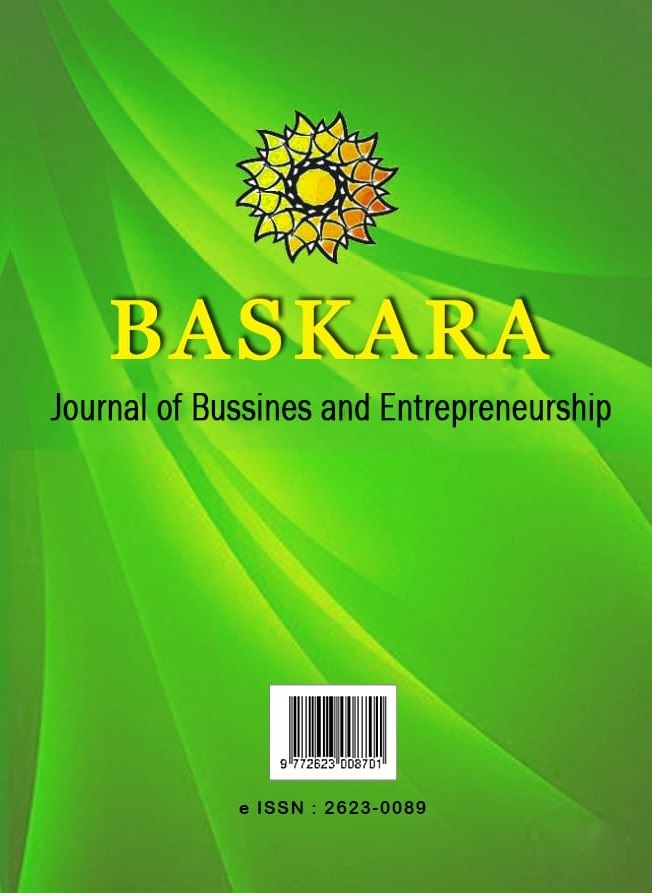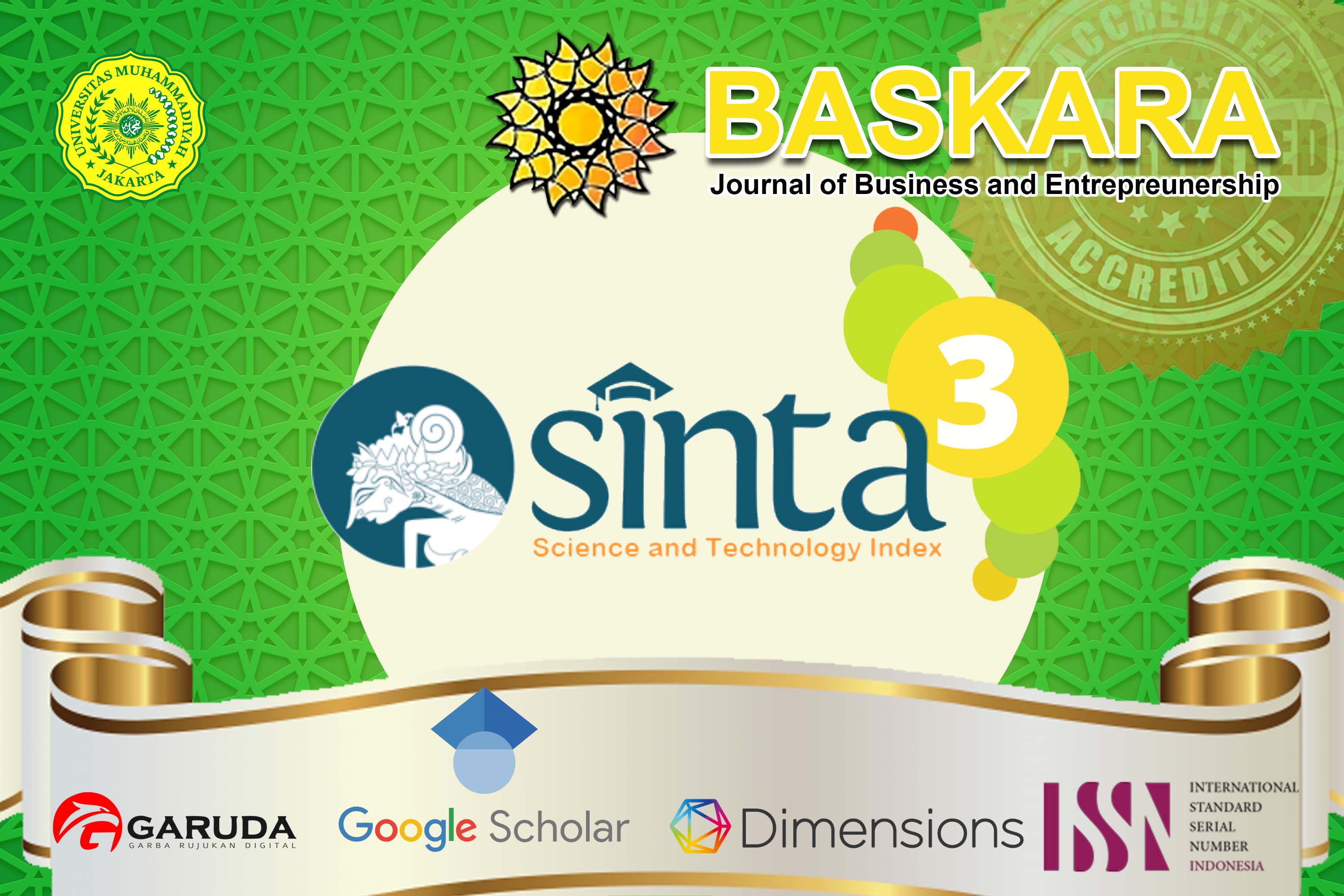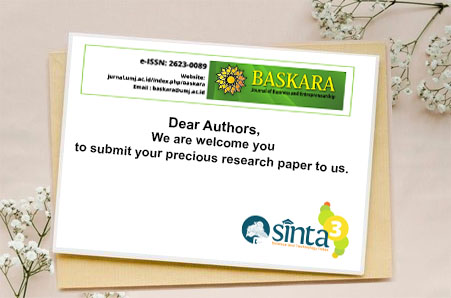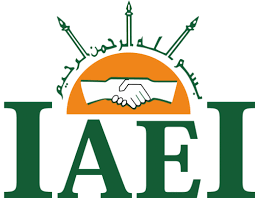Trust Mediates The Factors That Influence Purchase Intention For Co-Branded Local Cosmetics
DOI:
https://doi.org/10.54268/baskara.v6i2.20889Kata Kunci:
Purchase Intention, Co-Branded, Local Cosmetics, MarketingAbstrak
In the pursuit of enlightenment, this scholarly investigation unfolded through the distribution of meticulously crafted questionnaires and rigorous data computation. Consequently, the yielded results transcend mere numbers, including quantitative and qualitative elements. This analytical inspection aims to uncover the deep implications of things such as brand awareness, social media marketing, brand image, e-WoM (electronic word of mouth), brand equity, and trust. These elements, seen as potential mediators, hold the potential to exert influence on the purchase intention of co-branded local cosmetics products. The data employed in this scholarly inquiry were gathered through the dissemination of questionnaires among consumers who had previously acquired Co-Branded local cosmetics within the confines of Batam City in Indonesia. The collected responses underwent meticulous analysis, facilitated by the technological prowess of SmartPLS. The distribution of the questionnaires was executed via Google Forms, skillfully designed to adhere to specific terms and conditions. The outreach strategy encompassed both online and offline channels, ensuring a comprehensive and diverse participant pool. In the contemporary landscape, research on local cosmetics has emerged as a popular and pertinent topic. Notwithstanding, prevailing studies in this domain have predominantly concentrated on generic cosmetic sales strategies. Consequently, a noticeable research gap exists. This prompted the conception of the present analysis, aimed at enriching our understanding of marketing dynamics achieved through collaborative efforts between distinct brands. The specific focus is on exploring the ramifications of co-branding and its intrinsic impact on purchase intention, thereby contributing valuable insights to the current body of knowledge in this domain.Referensi
Ahn, J., Kim, A., & Sung, Y. (2019). The Effects of Sensory Fit on Consumer Evaluations of Co-branding. Https://Doi.Org/10.1080/02650487.2019.1652518, 39(4), 486–503. https://doi.org/10.1080/02650487.2019.1652518
Alita, D., Putra, A. D., & Darwis, D. (2021). Analysis of classic assumption test and multiple linear regression coefficient test for employee structural office recommendation. IJCCS (Indonesian Journal of Computing and Cybernetics Systems), 15(3), 295. https://doi.org/10.22146/ijccs.65586
Anggraini, W., & Noviarita, H. (2021). The Effect of Life Style and Islamic Branding on Consumer Decisions in Buying Muslim Gamis Fashion Products in Bandar Lampung. BASKARA: Journal of Business and Entrepreneurship, 4(1), 29–36.
Askaria, A. O., & Arief, M. (2021). Peran Green Marketing Terhadap Minat Beli Melalui Kepercayaan Merek (Studi Pada Produk Love Beauty and Planet). Jurnal Kajian Ilmu Manajemen, 1(4), 479–488. https://journal.trunojoyo.ac.id/jkim
Badan Pusat Statistik, Laju Pertumbuhan PDB Lapangan Usaha (Seri 2010). (2022). https://www.bps.go.id/indicator/11/104/1/-seri-2010-laju-pertumbuhan-pdb-seri-2010.html
Childs, M., & Jin, B. E. (2020). Brand and Retailer Co-branding: Examining Factors to Favourably Change Consumers’ Brand Evaluations. Journal of Fashion Marketing and Management, 24(1), 49–65. https://doi.org/10.1108/JFMM-03-2019-0061
Dhini, V. A. (2021). Produk Fesyen Paling Banyak Dicari Konsumen saat Belanja Online. Databoks.Katadata.Co.Id. https://databoks.katadata.co.id/datapublish/2021/10/27/produk-fesyen-paling-banyak-dicari-konsumen-saat-belanja-online
Dhisasmito, P. P., & Kumar, S. (2020). Understanding customer loyalty in the coffee shop industry (A survey in Jakarta, Indonesia). British Food Journal, 122(7), 2253–2271. https://doi.org/10.1108/BFJ-10-2019-0763
Dihni, V. A. (2022). 10 Merek Fesyen Favorit Masyarakat Indonesia, Siapa Juaranya? Databoks.Katadata.Co.Id.
https://databoks.katadata.co.id/datapublish/2022/03/15/10-merek-fesyen-favorit-masyarakat-indonesia-siapa-juaranya
Djafarova, E., & Bowes, T. (2021). ‘Instagram made Me buy it’: Generation Z impulse purchases in fashion industry. Journal of Retailing and Consumer Services, 59(xxxx), 102345. https://doi.org/10.1016/j.jretconser.2020.102345
Ellitan, L., Handayani, Y. I., & Bastian, D. (2021). The Impact of Green Marketing Mix and Brand Image on Customer Purchase Intention at Adidas Surabaya. In International Journal of Trend in Research and Development (Vol. 8, Issue 3). www.ijtrd.com
Fahlevi, R. (2020). Analisa Niat Mitra Penjual untuk Menggunakan Aplikasi Pengiriman Makanan Secara Daring. Jurnal Riset Manajemen Sekolah Tinggi Ilmu Ekonomi Widya Wiwaha Program Magister Manajemen, 7(2), 95–104. https://doi.org/10.32477/jrm.v7i2.199
Febriani, S. (2020). Pengaruh Green Marketing Mix Terhadap Green Product Purchase Intention pada Produk Innisfree di Jakarta dengan Consumer’s Attitude sebegai Variabel Mediasi. Jurnal Manajemen Bisnis Dan Kewirausahaan.
Gede, I., Sanjaya, A., & Seminari, N. K. (2021). The Role of Consumers’ Attitude Mediating Green Marketing on Purchase Intention (Study Case at Indonesian Beauty Brand “Bali Tangi”). American Journal of Humanities and Social Sciences Research, 5, 72–77. www.ajhssr.com
Hair, J. F., Sarstedt, M., Hopkins, L., & Kuppelwieser, V. G. (2014). Partial least squares structural equation modeling (PLS-SEM): An emerging tool in business research. In European Business Review (Vol. 26, Issue 2, pp. 106–121). Emerald Group Publishing Ltd. https://doi.org/10.1108/EBR-10-2013-0128
Hamid, M. R., Sami, W., & Mohmad, M. H. (2017). Discriminant Validity Assessment: Use of Fornell & Larcker criterion versus HTMT Criterion. Journal of Physics: Conference Series, 890(1). https://doi.org/10.1088/1742-6596/890/1/012163
Hutabarat, Z. (2022). Effect of Product Quality, Advertisement, and Brand Image on Purchase Decision Mediated By Customer Value of Louis Vuitton at Jabodetabek. BASKARA: Journal of Business and Entrepreneurship, 4(2), 58–71.
Kartawinata, B. R., Maharani, D., Maulana, S., Banten, Y., Pradana, M., & Amani, H. M. (2020). The Role of Customer Attitude in Mediating the Effect of Green Marketing Mix on Green Product Purchase Intention in Love Beauty and Planet Products in Indonesia.
Munamba, R., & Nuangjamnong, C. (2021). The Impact of Green Marketing Mix and Attitude towards the Green Purchase Intention among Generation y Consumers in Bangkok. SSRN Electronic Journal, 1–19. https://doi.org/10.2139/ssrn.3968444
Newmeyer, C. E., Venkatesh, R., Ruth, J. A., & Chatterjee, R. (2018). A Typology of Brand Alliances and Consumer Awareness of Brand Alliance Integration. Marketing Letters, 29(3), 275–289. https://doi.org/10.1007/S11002-018-9467-4
Peña-García, N., Gil-Saura, I., Rodríguez-Orejuela, A., & Siqueira-Junior, J. R. (2020). Purchase intention and purchase behavior online: A cross-cultural approach. Heliyon, 6(6). https://doi.org/10.1016/j.heliyon.2020.e04284
Puriwat, W., & Tripopsakul, S. (2022). Consumers’ Attitude towards Digital Social Responsibility: Impacts on Electronic Word of Mouth and Purchase Intention. Emerging Science Journal, 6(1), 64–74. https://doi.org/10.28991/ESJ-2022-06-01-05
Purwianti, L. (2021). Pengaruh Religiostik, EWOM, Brand Image dan Attitude terhadap Purchase Intention. Jurnal Ecodemica: Jurnal Ekonomi, Manajemen, Dan Bisnis, 5(1), 40–50. https://doi.org/10.31294/jeco.v5i1.9284
Sharma, N. K. (2022). Instruments Used in the Collection of Data in Research. In Poonam Shodh Rachna (Vol. 1). www.poonamshodh.in
Statista Team. (2022). Fashion - Indonesia | Statista Market Forecast. Statista.Com.
https://www.statista.com/outlook/dmo/ecommerce/fashion/indonesia
Taber, K. S. (2018). The Use of Cronbach’s Alpha When Developing and Reporting Research Instruments in Science Education. Research in Science Education, 48(6), 1273–1296. https://doi.org/10.1007/S11165-016-9602-2/TABLES/1
Taherdoost, H. (2022). What are Different Research Approaches? Comprehensive Review of Qualitative, Quantitative, and Mixed Method Research, Their Applications, Types, and Limitations. Journal of Management Science & Engineering Research, 5(1), 53–63. https://doi.org/10.30564/jmser.v5i1.4538
Turan, C. P. (2021). Success Drivers of Co-Branding: A Meta-Analysis. International Journal of Consumer Studies, August 2020, 911–936. https://doi.org/10.1111/ijcs.12682
Turner, D. P. (2020). Sampling Methods in Research Design. Headache, 60(1), 8–12. https://doi.org/10.1111/head.13707
Valtakoski, A. (2020). The Evolution and Impact of Qualitative Research in Journal of Services Marketing. Journal of Services Marketing, 34(1), 8–23. https://doi.org/10.1108/JSM-12-2018-0359
Wang, X., & Cheng, Z. (2020). Cross-Sectional Studies: Strengths, Weaknesses, and Recommendations. Chest, 158(1), S65–S71. https://doi.org/10.1016/J.CHEST.2020.03.012
Yu, Y., Rothenberg, L., & Moore, M. (2021). Exploring young consumer’s decision‐making for luxury co-branding combinations. International Journal of Retail and Distribution Management, 49(3), 341–358. https://doi.org/10.1108/IJRDM-12-2019-0399
##submission.downloads##
Diterbitkan
Terbitan
Bagian
Lisensi
In order for Baskara: Journal of Business and Entrepreneurship to publish and disseminate research articles, we need publishing rights (transfered from author(s) to publisher). This is determined by a publishing agreement between the Author(s) and Baskara Journal. This agreement deals with the transfer or license of the copyright of publishing to Baskara: Journal of Business and Entrepreneurship, while Authors still retain significant rights to use and share their own published articles. Baskara : Journal of Business and Entrepreneurship supports the need for authors to share, disseminate and maximize the impact of their research and these rights, in any databases.
As a journal Author, you have rights for a large range of uses of your article, including use by your employing institute or company. These Author rights can be exercised without the need to obtain specific permission. Authors publishing in Baskara : Journal of Business and Entrepreneurship have wide rights to use their works for teaching and scholarly purposes without needing to seek permission, including:
- use for classroom teaching by Author or Author's institution and presentation at a meeting or conference and distributing copies to attendees;
- use for internal training by author's company;
- distribution to colleagues for their reseearch use;
- use in a subsequent compilation of the author's works;
- inclusion in a thesis or dissertation;
- reuse of portions or extracts from the article in other works (with full acknowledgement of final article);
- preparation of derivative works (other than commercial purposes) (with full acknowledgement of final article);
- voluntary posting on open web sites operated by author or author’s institution for scholarly purposes.
Copyright Transfer Agreement for Publishing (Publishing Right)
The Authors who submit manuscript has to understand that if accepted for publication, mean that all copyright and publishing right of the article shall be assigned/transferred to Baskara: Journal of Business and Entrepreneurship as assigned publisher.
- CC BY-NC: This license allows reusers to distribute, remix, adapt, and build upon the material in any medium or format for noncommercial purposes only, and only so long as attribution is given to the creator.
It includes the following elements:
BY ![]() – Credit must be given to the creator
– Credit must be given to the creator
NC ![]() – Only noncommercial uses of the work are permitted
– Only noncommercial uses of the work are permitted
Baskara (C) Copyright (2022):
BASKARA: Journal of Business and Entrepreneurship by https://jurnal.umj.ac.id/index.php/baskara
is licensed under a Creative Commons Attribution-NonCommercial 4.0 International License








